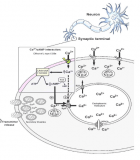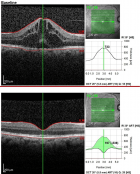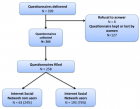Abstract
Short Communication
The “Calcium Paradox” Due To Ca2+/Camp Interaction: New Insights for the Neuroscience Field
Leandro Bueno Bergantin* and Afonso Caricati-Neto
Published: 21 February, 2017 | Volume 1 - Issue 1 | Pages: 012-015
In the cardiovascular field, tachycardia and increment of catecholamine plasma levels (sympathetic hyperactivity) have been reported by hypertensive patients that use L-type Ca2+ channel blockers (CCBs) since 70´s. Our discovery of the involvement of interaction between the intracellular signalling pathways mediated by Ca2+ and cAMP (Ca2+/cAMP interaction) revealed that this phenomenon (sympathetic hyperactivity) was resulting of increase of transmitter release from sympathetic neurons stimulated by CCBs due to its interference on the Ca2+/cAMP interaction. In the neuroscience field, this discovery has produced new paths for the understanding of the cellular and molecular mechanisms involved in the pathogenesis of neurodegenerative diseases, such as Alzheimer´s and Parkinson’s diseases. In this way, novel journeys for the development of new pharmacological strategies more effective for the treatment of neurodegenerative diseases may be initiated.
Read Full Article HTML DOI: 10.29328/journal.jnnd.1001002 Cite this Article Read Full Article PDF
Keywords:
Ca2+/cAMP interaction; “Calcium paradox”; Neurodegenerative diseases
References
- Reuse of portions or extracts from the article in other works- https://www.elsevier.com/__data/assets/pdf_file/0007/55654/AuthorUserRights.pdf
- REFERENCES
- Chern YJ, Kim KT, Slakey LL, Westhead EW. Adenosine receptors activate adenylate cyclase and enhance secretion from bovine adrenal chromaffin cells in the presence of forskolin. J Neurochem. 1988; 50: 1484-1493. Ref.: https://goo.gl/D3U5F0
- Douglas WW, Rubin RP. The role of calcium in the secretory response of the adrenal medulla to acetylcholine. J Physiol. 1961; 159: 40-57. Ref.: https://goo.gl/Lwekpm
- Baker PF, Knight DE. Calcium-dependent exocytosis in bovine adrenal medullary cells with leaky plasma membranes. Nature. 1978; 276: 620-622. Ref.: https://goo.gl/bvf8DR
- Neher E, Zucker RS. Multiple calcium-dependent processes related to secretion in bovine chromaffin cells. Neuron. 1993; 10: 21-30. Ref.: https://goo.gl/3fvzjy
- Caricati-Neto A, García AG, Bergantin LB. Pharmacological implications of the Ca2+/cAMP signalling interaction: from risk for antihypertensive therapy to potential beneficial for neurological and psychiatric disorders. Pharmacol Res Perspect. 2015; 3: e00181. Ref.: https://goo.gl/UiQrGs
- Bergantin LB, Souza CF, Ferreira RM, Smaili SS, Jurkiewicz NH, et al. Novel model for “calcium paradox” in sympathetic transmission of smooth muscles: role of cyclic AMP pathway. Cell Calcium. 2013; 54: 202-212. Ref.: https://goo.gl/HHou6F
- Bergantin LB, Jurkiewicz A, García AG, Caricati-Neto A. A Calcium Paradox in the Context of Neurotransmission. Journal of Pharmacy and Pharmacology. 2015; 3: 253-261. Ref.: https://goo.gl/ltkVhv
- Bergantin LB, Caricati-Neto A. Challenges for the pharmacological treatment of neurological and psychiatric disorders: Implications of the Ca2+/cAMP intracellular signalling interaction. Eur J Pharmacol. 2016; 788: 255-260. Ref.: https://goo.gl/u21xBi
- Grossman E, Messerli FH. Effect of calcium antagonists on sympathetic activity. Eur Heart J. 1998; 19: F27-F31. Ref.: https://goo.gl/BQkkG1
- Kreye VA, Luth JB. Proceedings: verapamil-induced phasic contractions of the isolated rat vas deferens. Naunyn Schmiedebergs Arch Pharmacol. 1975; 287: R43. Ref.: https://goo.gl/Z07NA4
- French AM, Scott NC. A comparison of the effects of nifedipine and verapamil on rat vas deferens. Br J Pharmacol. 1981; 73: 321-323. Ref.: https://goo.gl/d8wrcd
- Moritoki H, Iwamoto T, Kanaya J, Maeshiba Y, Ishida Y, et al. Verapamil enhances the non-adrenergic twitch response of rat vas deferens. Eur J Pharmacol. 1987; 140: 75-83. Ref.: https://goo.gl/OKoviM
- Sommer N, Loschmann PA, Northoff GH, Weller M, Steinbrecher A, et al. The antidepressant rolipram suppresses cytokine production and prevents autoimmune encephalomyelitis. Nat Med. 1995; 1: 244-248. Ref.: https://goo.gl/MiganR
- Xiao L, O'Callaghan JP, O'Donnell JM. Effects of repeated treatment with phosphodiesterase-4 inhibitors on cAMP signaling, hippocampal cell proliferation, and behavior in the forced-swim test. J Pharmacol Exp Ther. 2011; 338: 641-647. Ref.: https://goo.gl/14xO4A
- Bergantin LB, Caricati-Neto A. Novel Insights for Therapy of Parkinson’s disease: Pharmacological Modulation of the Ca2+/cAMP Signalling Interaction. Austin Neurol & Neurosci. 2016; 1: 1009. Ref.: https://goo.gl/ujivdj
- Bergantin LB, Caricati-Neto A. Recent advances in pharmacotherapy of neurological and psychiatric disorders promoted by discovery of the role of Ca2+/cAMP signaling interaction in the neurotransmission and neuroprotection. Adv Pharmac J. 2016; 1: 66.
- Halls ML, Cooper DM. Adenylyl cyclase signalling complexes - Pharmacological challenges and opportunities. Pharmacol Ther. 2017; 7258: 30011-30016. Ref.: https://goo.gl/VDeVKV
- Cooper DM, Mons N, Karpen JW. Adenylyl cyclases and the interaction between calcium and cAMP signalling. Nature. 1995; 374: 421-424. Ref.: https://goo.gl/OVc1JP
- Bereczki E, Francis PT, Howlett D, Pereira JB, Höglund K, et al. Synaptic proteins predict cognitive decline in Alzheimer`s disease and Lewy body dementia. Alzheimers Dement. 2016; 12: 1149-1158. Ref.: https://goo.gl/pch8Cq
- Clare R, King VG, Wirenfeldt M, Vinters HV. Synapse loss in dementias. J Neurosci Res. 2010; 88: 2083-2090. Ref.: https://goo.gl/5sJRu7
Figures:

Figure 1
Similar Articles
-
The “Calcium Paradox” Due To Ca2+/Camp Interaction: New Insights for the Neuroscience FieldLeandro Bueno Bergantin*, Afonso Caricati-Neto. The “Calcium Paradox” Due To Ca2+/Camp Interaction: New Insights for the Neuroscience Field. . 2017 doi: 10.29328/journal.jnnd.1001002; 1: 012-015
-
Protective functions of AEURA in Cell Based Model of Stroke and Alzheimer diseaseJigar Modi,Ahmed Altamimi,Ashleigh Morrell,Hongyuan Chou,Janet Menzie,Andrew Weiss,Michael L Marshall, Andrew Li,Howard Prentice*,Jang-Yen Wu*. Protective functions of AEURA in Cell Based Model of Stroke and Alzheimer disease. . 2017 doi: 10.29328/journal.jnnd.1001003; 1: 016-023
-
Role of plants, environmental toxins and physical neurotoxicological factors in Amyotrophic lateral sclerosis, Alzheimer Disease and other Neurodegenerative DiseasesMauro Luisetto*,Naseer Almukhtar,Ahmed Yesvi Rafa,Behzad Nili Ahmadabadi,Ghulam Rasool Mashori,Farhan Ahmad Khan,Ram Kumar Sahu,Gamal Abdul Hamid,Khaled Edbey. Role of plants, environmental toxins and physical neurotoxicological factors in Amyotrophic lateral sclerosis, Alzheimer Disease and other Neurodegenerative Diseases. . 2019 doi: 10.29328/journal.jnnd.1001019; 3: 001-086
-
Protection from the Pathogenesis of Neurodegenerative Disorders, including Alzheimer’s Disease, Amyotrophic Lateral Sclerosis, Huntington’s Disease, and Parkinson’s Diseases, through the Mitigation of Reactive Oxygen SpeciesSamskruthi Madireddy*,Sahithi Madireddy. Protection from the Pathogenesis of Neurodegenerative Disorders, including Alzheimer’s Disease, Amyotrophic Lateral Sclerosis, Huntington’s Disease, and Parkinson’s Diseases, through the Mitigation of Reactive Oxygen Species. . 2019 doi: 10.29328/journal.jnnd.1001026; 3: 148-161
-
The Neuroprotective Role of TERT Influences the Expression of SOD1 in Motor Neurons and Mouse Brain: Implications for fALSAilone Tichon, Erez Eitan, Sylvia Tsory, Elie Beit-Yanai, Esther Priel*. The Neuroprotective Role of TERT Influences the Expression of SOD1 in Motor Neurons and Mouse Brain: Implications for fALS. . 2023 doi: 10.29328/journal.jnnd.1001085; 7: 113-125
Recently Viewed
-
Gilbert’s Syndrome Revealed by Hepatotoxicity of ImatinibImen Ben Amor*,Imen Frikha,Moez Medhaffer,Moez Elloumi. Gilbert’s Syndrome Revealed by Hepatotoxicity of Imatinib. Ann Clin Gastroenterol Hepatol. 2025: doi: 10.29328/journal.acgh.1001049; 9: 001-003
-
Unusual Complications of a Dental Prosthesis Esophageal Foreign Body: About a CaseRichard Edward Alain Deguenonvo,Ndèye Fatou Thiam*,Mouhamadou Diouldé Diallo,Abdou Sy,Amadou Thiam,Abdoulaye Diop,Mame Sanou Diouf,Baye Karim Diallo. Unusual Complications of a Dental Prosthesis Esophageal Foreign Body: About a Case. Adv Treat ENT Disord. 2025: doi: 10.29328/journal.ated.1001016; 9: 001-004
-
Strengthening Healthcare Delivery in the Democratic Republic of Congo through Adequate Nursing WorkforceMin Kyung Shin, Tshibambe N Tshimbombu*. Strengthening Healthcare Delivery in the Democratic Republic of Congo through Adequate Nursing Workforce. Clin J Nurs Care Pract. 2024: doi: 10.29328/journal.cjncp.1001051; 8: 007-010
-
Chemical constituents and biological activities of Artocarpus heterophyllus lam (Jackfruit): A reviewSibi G*,Pranay Raja Bhad,Meeneri Vilas Bobde. Chemical constituents and biological activities of Artocarpus heterophyllus lam (Jackfruit): A review. Int J Clin Microbiol Biochem Technol. 2021: doi: 10.29328/journal.ijcmbt.1001019; 4: 005-009
-
The clinicopathological correlates of Cystoisosporiasis in immunocompetent, immunocompromised and HIV-infected/AIDS patients, but neglected in SARS-COV-2/COVID-19 patients?Chrysanthus Chukwuma Sr*. The clinicopathological correlates of Cystoisosporiasis in immunocompetent, immunocompromised and HIV-infected/AIDS patients, but neglected in SARS-COV-2/COVID-19 patients?. Int J Clin Microbiol Biochem Technol. 2021: doi: 10.29328/journal.ijcmbt.1001018; 4: 001-004
Most Viewed
-
Evaluation of Biostimulants Based on Recovered Protein Hydrolysates from Animal By-products as Plant Growth EnhancersH Pérez-Aguilar*, M Lacruz-Asaro, F Arán-Ais. Evaluation of Biostimulants Based on Recovered Protein Hydrolysates from Animal By-products as Plant Growth Enhancers. J Plant Sci Phytopathol. 2023 doi: 10.29328/journal.jpsp.1001104; 7: 042-047
-
Sinonasal Myxoma Extending into the Orbit in a 4-Year Old: A Case PresentationJulian A Purrinos*, Ramzi Younis. Sinonasal Myxoma Extending into the Orbit in a 4-Year Old: A Case Presentation. Arch Case Rep. 2024 doi: 10.29328/journal.acr.1001099; 8: 075-077
-
Feasibility study of magnetic sensing for detecting single-neuron action potentialsDenis Tonini,Kai Wu,Renata Saha,Jian-Ping Wang*. Feasibility study of magnetic sensing for detecting single-neuron action potentials. Ann Biomed Sci Eng. 2022 doi: 10.29328/journal.abse.1001018; 6: 019-029
-
Pediatric Dysgerminoma: Unveiling a Rare Ovarian TumorFaten Limaiem*, Khalil Saffar, Ahmed Halouani. Pediatric Dysgerminoma: Unveiling a Rare Ovarian Tumor. Arch Case Rep. 2024 doi: 10.29328/journal.acr.1001087; 8: 010-013
-
Physical activity can change the physiological and psychological circumstances during COVID-19 pandemic: A narrative reviewKhashayar Maroufi*. Physical activity can change the physiological and psychological circumstances during COVID-19 pandemic: A narrative review. J Sports Med Ther. 2021 doi: 10.29328/journal.jsmt.1001051; 6: 001-007

HSPI: We're glad you're here. Please click "create a new Query" if you are a new visitor to our website and need further information from us.
If you are already a member of our network and need to keep track of any developments regarding a question you have already submitted, click "take me to my Query."
















































































































































